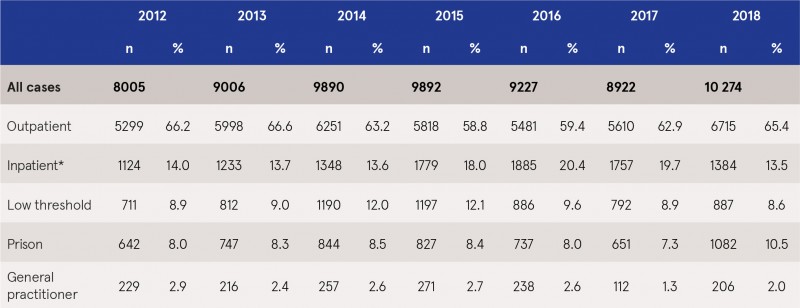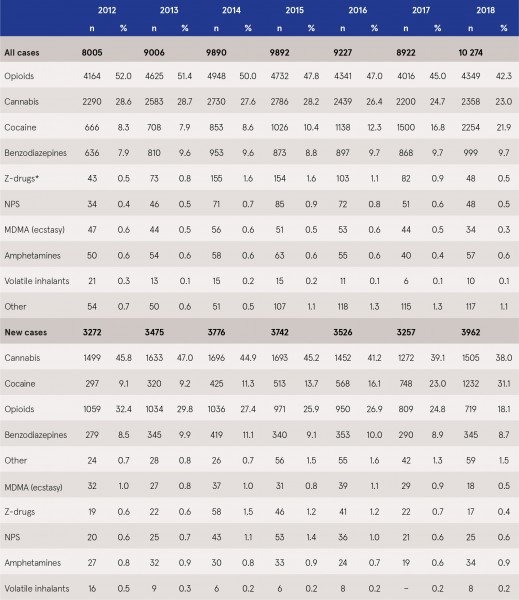Kelleher, Cathy (2020) Drug treatment in Ireland 2012–2018. Drugnet Ireland, Issue 72, Winter 2020, pp. 9-11.
| Preview | Title | Contact |
|---|---|---|
|
PDF (Drugnet 72)
- Published Version
600kB |
Published in November 2019, the latest National Drug Treatment Reporting System (NDTRS) drug bulletin presents trends in treated problem drug use (excluding alcohol) for the seven-year period from 2012 to 2018.1,2
Key findings
Over the period, 65,216 cases treated for problem drug use were reported to the NDTRS.3 In 2018, the NDTRS recorded 10,274 treated cases, an increase from 8,005 in 2012 (see Table 1).4 New cases (never previously treated) accounted for 40.9% of cases in 2012 and 38.6% in 2018. Previously treated cases accounted for 56.4% of cases in 2012 and 57.2% in 2018.
In 2018, almost two-thirds (65.4%) of cases were treated in outpatient facilities (as in previous years), 13.5% of cases were treated in inpatient facilities, 10.5% in prisons, 8.6% in low-threshold services, and 2% by general practitioners (see Table 2).
Main problem drug
Opioids (mainly heroin) were the main problem drug reported in 2018 and over the period. As a proportion of all cases treated, opioids decreased year-on-year from 52% in 2012 to 42.3% in 2018 (see Table 3).
Cannabis remains the second most common main drug reported over the period. The proportion of cases treated decreased from 28.6% in 2012 to 23% in 2018.
Cocaine was the third most common main drug reported, accounting for 21.9% of cases in 2018. The number of cases treated for cocaine increased year-on-year from 2013 (708 cases) to 2018 (2,254 cases), an increase of 218%. The most significant yearly increase in the number of cases presenting with cocaine as a main problem occurred between 2017 (1,500 cases) and 2018 (2,254 cases), an increase of 50.3%.
In 2018, cannabis (38%) was the most common main problem drug reported by new entrants to treatment, followed by cocaine (31.1%) and opioids (18.1%) (see Table 3). Cocaine represented 31.1% of new cases in 2018, as compared with 9.1% in 2012.
Table 1: Number of cases treated for problem drug use, by treatment status, NDTRS 2012–2018

Table 2: Number of cases treated for problem drug use, by type of service provider, NDTRS 2012–2018

* Includes any service where the client stays overnight, e.g. inpatient detoxification, therapeutic communities, respite, and step-down.
Table 3: Main problem drug (excluding alcohol) reported in 30 days prior to treatment, NDTRS 2012–2018

* Z-drugs are non-benzodiazepine hypnotic sedative drugs, e.g. zolpidem and zopiclone.
NPS: New psychoactive substances.
~ Cells with five cases or less.
Polydrug use
Over the period 2012–2018, six in 10 cases (59.5%) reported polydrug use (i.e. problem use of more than one drug). The proportion of cases with polydrug use decreased from 61.5% in 2012 to 53.4% in 2018 (see Table 4). Alcohol (37.4%), benzodiazepines (36.2%), cannabis (35.3%), and cocaine (29.5%) were the most commonly reported additional drugs in 2018.
Risk behaviour
The proportion of all cases that had ever injected decreased from 36% in 2012 to 26.7% in 2018 (a decrease of 142 cases over the period). Among new cases, the proportion that reported ever injecting decreased from 18% in 2012 to 7.9% in 2018. The proportion of all cases currently injecting (i.e. in the 30 days prior to treatment) decreased from 35.6% in 2012 to 29.7% in 2018.
Sociodemographic characteristics
The following sociodemographic characteristics of the cases were noted:
- Seven in every 10 cases reported over the period were male.
- The median age of cases when entering treatment increased from 28 years in 2012 to 31 years in 2018.
- Under 18s accounted for 8.4% of cases in 2012 and 7.1% in 2018.
- Cases recorded as homeless increased in proportion, from 5.8% in 2012 to 9.5% in 2018.
- The proportion of cases with an Irish Traveller ethnicity was 2.8% in 2012 and 3.3% in 2018.
- A large proportion of cases (61.9%) were unemployed in 2018, as in previous years.
- The proportion of cases in paid employment increased from 7.2% in 2012 to 16.9% in 2018.
Sociodemographic characteristics of cases – cocaine as main problem
The following sociodemographic characteristics of cases with cocaine as a main problem were noted:
- Eight in 10 cases reported over the period were male.
- The proportion of female cases increased from 18% in 2012 to 20.1% in 2018.
- The median age of cases when entering treatment increased from 29 years in 2012 to 30 years in 2018.
- Under 18s accounted for 1.4% of cocaine cases in 2012 and 1.7% in 2018.
- The proportion of cases in paid employment increased from 15.8% in 2012 to 35% in 2018.
- Cases with polydrug use decreased in proportion, from 76.6% in 2012 to 56.1% in 2018.
- In 2018, the most common additional substances were alcohol (56%), cannabis (47.8%), and benzodiazepines (23.8%).
Table 4: Polydrug use in cases treated for problem drug use, NDTRS 2012–2018
1 The NDTRS is the national epidemiological surveillance system that reports on treated problem drug and alcohol use in Ireland. Established in 1990, the NDTRS is maintained by the National Health Information Systems (NHIS) of the Health Research Board (HRB) on behalf of the Department of Health.
2 Health Research Board (2019) National Drug Treatment Reporting System 2012–2018 drug data. Dublin: Health Research Board. Available online at: http://www.drugsandalcohol.ie/30969 and at
http://www.hrb.ie/publications. Alcohol figures are published in a separate bulletin.
3 The data reflect the number of entries into treatment in a calendar year, rather than the number of persons treated in that year.
4 The number of services participating in the NDTRS varies annually, making small fluctuations in the numbers of cases difficult
G Health and disease > Substance use disorder (addiction) > Multiple substance use (Poly-drug /Poly-substance)
J Health care, prevention, harm reduction and treatment > Health care programme, service or facility
VA Geographic area > Europe > Ireland
Repository Staff Only: item control page